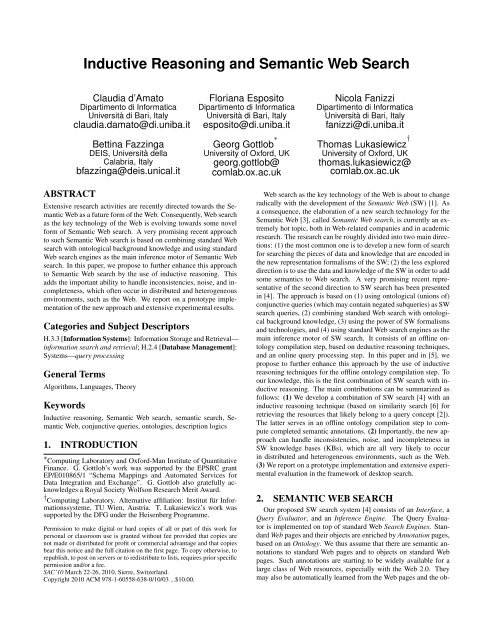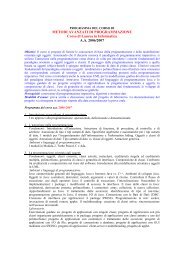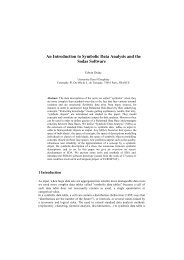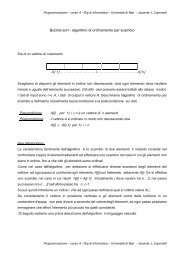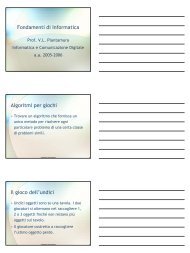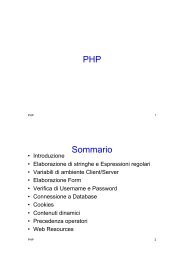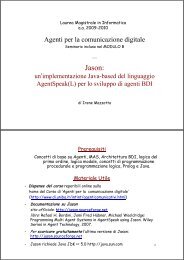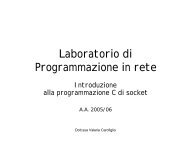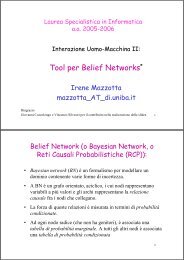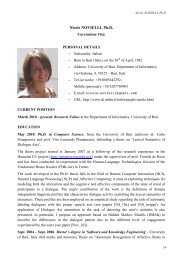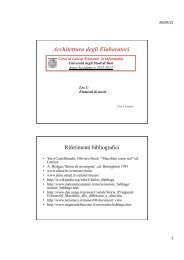Inductive Reasoning and Semantic Web Search
Inductive Reasoning and Semantic Web Search
Inductive Reasoning and Semantic Web Search
Create successful ePaper yourself
Turn your PDF publications into a flip-book with our unique Google optimized e-Paper software.
<strong>Inductive</strong> <strong>Reasoning</strong> <strong>and</strong> <strong>Semantic</strong> <strong>Web</strong> <strong>Search</strong>Claudia d’AmatoDipartimento di InformaticaUniversità di Bari, Italyclaudia.damato@di.uniba.itBettina FazzingaDEIS, Università dellaCalabria, Italybfazzinga@deis.unical.itFloriana EspositoDipartimento di InformaticaUniversità di Bari, Italyesposito@di.uniba.itGeorg Gottlob ∗University of Oxford, UKgeorg.gottlob@comlab.ox.ac.ukNicola FanizziDipartimento di InformaticaUniversità di Bari, Italyfanizzi@di.uniba.itThomas Lukasiewicz †University of Oxford, UKthomas.lukasiewicz@comlab.ox.ac.ukABSTRACTExtensive research activities are recently directed towards the <strong>Semantic</strong><strong>Web</strong> as a future form of the <strong>Web</strong>. Consequently, <strong>Web</strong> searchas the key technology of the <strong>Web</strong> is evolving towards some novelform of <strong>Semantic</strong> <strong>Web</strong> search. A very promising recent approachto such <strong>Semantic</strong> <strong>Web</strong> search is based on combining st<strong>and</strong>ard <strong>Web</strong>search with ontological background knowledge <strong>and</strong> using st<strong>and</strong>ard<strong>Web</strong> search engines as the main inference motor of <strong>Semantic</strong> <strong>Web</strong>search. In this paper, we propose to further enhance this approachto <strong>Semantic</strong> <strong>Web</strong> search by the use of inductive reasoning. Thisadds the important ability to h<strong>and</strong>le inconsistencies, noise, <strong>and</strong> incompleteness,which often occur in distributed <strong>and</strong> heterogeneousenvironments, such as the <strong>Web</strong>. We report on a prototype implementationof the new approach <strong>and</strong> extensive experimental results.Categories <strong>and</strong> Subject DescriptorsH.3.3 [Information Systems]: Information Storage <strong>and</strong> Retrieval—information search <strong>and</strong> retrieval; H.2.4 [Database Management]:Systems—query processingGeneral TermsAlgorithms, Languages, TheoryKeywords<strong>Inductive</strong> reasoning, <strong>Semantic</strong> <strong>Web</strong> search, semantic search, <strong>Semantic</strong><strong>Web</strong>, conjunctive queries, ontologies, description logics1. INTRODUCTION∗ Computing Laboratory <strong>and</strong> Oxford-Man Institute of QuantitativeFinance. G. Gottlob’s work was supported by the EPSRC grantEP/E010865/1 “Schema Mappings <strong>and</strong> Automated Services forData Integration <strong>and</strong> Exchange”. G. Gottlob also gratefully acknowledgesa Royal Society Wolfson Research Merit Award.† Computing Laboratory. Alternative affiliation: Institut für Informationssysteme,TU Wien, Austria. T. Lukasiewicz’s work wassupported by the DFG under the Heisenberg Programme.Permission to make digital or hard copies of all or part of this work forpersonal or classroom use is granted without fee provided that copies arenot made or distributed for profit or commercial advantage <strong>and</strong> that copiesbear this notice <strong>and</strong> the full citation on the first page. To copy otherwise, torepublish, to post on servers or to redistribute to lists, requires prior specificpermission <strong>and</strong>/or a fee.SAC’10 March 22-26, 2010, Sierre, Switzerl<strong>and</strong>.Copyright 2010 ACM 978-1-60558-638-0/10/03 ...$10.00.<strong>Web</strong> search as the key technology of the <strong>Web</strong> is about to changeradically with the development of the <strong>Semantic</strong> <strong>Web</strong> (SW) [1]. Asa consequence, the elaboration of a new search technology for the<strong>Semantic</strong> <strong>Web</strong> [3], called <strong>Semantic</strong> <strong>Web</strong> search, is currently an extremelyhot topic, both in <strong>Web</strong>-related companies <strong>and</strong> in academicresearch. The research can be roughly divided into two main directions:(1) the most common one is to develop a new form of searchfor searching the pieces of data <strong>and</strong> knowledge that are encoded inthe new representation formalisms of the SW; (2) the less exploreddirection is to use the data <strong>and</strong> knowledge of the SW in order to addsome semantics to <strong>Web</strong> search. A very promising recent representativeof the second direction to SW search has been presentedin [4]. The approach is based on (1) using ontological (unions of)conjunctive queries (which may contain negated subqueries) as SWsearch queries, (2) combining st<strong>and</strong>ard <strong>Web</strong> search with ontologicalbackground knowledge, (3) using the power of SW formalisms<strong>and</strong> technologies, <strong>and</strong> (4) using st<strong>and</strong>ard <strong>Web</strong> search engines as themain inference motor of SW search. It consists of an offline ontologycompilation step, based on deductive reasoning techniques,<strong>and</strong> an online query processing step. In this paper <strong>and</strong> in [5], wepropose to further enhance this approach by the use of inductivereasoning techniques for the offline ontology compilation step. Toour knowledge, this is the first combination of SW search with inductivereasoning. The main contributions can be summarized asfollows: (1) We develop a combination of SW search [4] with aninductive reasoning technique (based on similarity search [6] forretrieving the resources that likely belong to a query concept [2]).The latter serves in an offline ontology compilation step to computecompleted semantic annotations. (2) Importantly, the new approachcan h<strong>and</strong>le inconsistencies, noise, <strong>and</strong> incompleteness inSW knowledge bases (KBs), which are all very likely to occurin distributed <strong>and</strong> heterogeneous environments, such as the <strong>Web</strong>.(3) We report on a prototype implementation <strong>and</strong> extensive experimentalevaluation in the framework of desktop search.2. SEMANTIC WEB SEARCHOur proposed SW search system [4] consists of an Interface, aQuery Evaluator, <strong>and</strong> an Inference Engine. The Query Evaluatoris implemented on top of st<strong>and</strong>ard <strong>Web</strong> <strong>Search</strong> Engines. St<strong>and</strong>ard<strong>Web</strong> pages <strong>and</strong> their objects are enriched by Annotation pages,based on an Ontology. We thus assume that there are semantic annotationsto st<strong>and</strong>ard <strong>Web</strong> pages <strong>and</strong> to objects on st<strong>and</strong>ard <strong>Web</strong>pages. Such annotations are starting to be widely available for alarge class of <strong>Web</strong> resources, especially with the <strong>Web</strong> 2.0. Theymay also be automatically learned from the <strong>Web</strong> pages <strong>and</strong> the ob-
jects to be annotated, <strong>and</strong>/or they may be extracted from existingontological KBs on the SW. Another assumption that we make isthat <strong>Web</strong> pages <strong>and</strong> their objects have unique identifiers. For example,a <strong>Web</strong> page i 1 may contain information about a Ph.D. studenti 2, called Mary, <strong>and</strong> two of her papers: a conference paperi 3 entitled “<strong>Semantic</strong> <strong>Web</strong> search" <strong>and</strong> a journal paper i 4 entitled“<strong>Semantic</strong> <strong>Web</strong> search engines" <strong>and</strong> published in 2008. There maynow exist one semantic annotation each for the <strong>Web</strong> page, the Ph.D.student Mary, the journal paper, <strong>and</strong> the conference paper. The semanticannotations of i 1, i 2, i 3, <strong>and</strong> i 4 are formally expressed asthe sets of axioms A i1 , A i2 , A i3 , <strong>and</strong> A i4 , respectively:A i1 = {contains(i 1 , i 2 ), contains(i 1 , i 3 ), contains(i 1 , i 4 )},A i2 = {PhDStudent(i 2 ), name(i 2 , “mary”), isAuthorOf(i 2 , i 3 ),isAuthorOf(i 2 , i 4 )},A i3 = {ConferencePaper(i 3 ), title(i 3 , “<strong>Semantic</strong> <strong>Web</strong> search”)},A i4 = {JournalPaper(i 4 ), hasAuthor(i 4 , i 2 ),title(i 4 , “<strong>Semantic</strong> <strong>Web</strong> search engines”),yearOfPublication(i 4 , 2008), keyword(i 4 , “RDF”)} .Using an ontology containing some background knowledge, thesesemantic annotations are then further enhanced in an offline ontologycompilation step, where the Inference Engine adds all propertiesthat can be deduced from the semantic annotations <strong>and</strong> theontology. In [4], this is performed by a deductive such step. Here<strong>and</strong> in [5], we propose <strong>and</strong> explore the exploitation of inductive reasoning.For example, an ontology may contain the knowledge thatall journal <strong>and</strong> conference papers are also articles, that conferencepapers are not journal papers, <strong>and</strong> that “is author of” is the inverserelation to “has author”, which is formally expressed by:ConferencePaper ⊑ Article, JournalPaper ⊑ Article,ConferencePaper ⊑ ¬JournalPaper,isAuthorOf − ⊑ hasAuthor, hasAuthor − ⊑ isAuthorOf .Using this knowledge, we can derive from the above annotationsthat papers i 3 <strong>and</strong> i 4 are also articles, <strong>and</strong> both authored by John.These resulting (completed) semantic annotations of (objects on)st<strong>and</strong>ard <strong>Web</strong> pages are published as HTML <strong>Web</strong> pages with pointersto the respective object pages, so that they (in addition to thest<strong>and</strong>ard <strong>Web</strong> pages) can be searched by st<strong>and</strong>ard search engines.The Query Evaluator reduces each SW search query of the userin an online query processing step to a sequence of st<strong>and</strong>ard <strong>Web</strong>search queries on st<strong>and</strong>ard <strong>Web</strong> <strong>and</strong> annotation pages, which arethen processed by a st<strong>and</strong>ard <strong>Web</strong> <strong>Search</strong> Engine. As an exampleof a <strong>Semantic</strong> <strong>Web</strong> search query, one may ask for all Ph.D. studentswho have published an article in 2008 with RDF as a keyword,which is formally expressed as follows:Q(x) = ∃y (PhDStudent(x) ∧ isAuthorOf(x, y) ∧ Article(y) ∧yearOfPublication(y, 2008) ∧ keyword(y, “RDF ”)) .This query is transformed into the two queries Q 1 = PhDStudentAND isAuthorOf <strong>and</strong> Q 2 = Article AND “yearOfPublication 2008”AND “keyword RDF”, which can both be submitted to a st<strong>and</strong>ard<strong>Web</strong> search engine, such as Google. The result of the original queryQ is then built from the results of the two queries Q 1 <strong>and</strong> Q 2.3. INDUCTIVE REASONINGWe now illustrate the main advantages of using inductive ratherthan deductive reasoning in SW search, namely, that inductive reasoning(differently from deductive reasoning) can h<strong>and</strong>le inconsistencies,noise, <strong>and</strong> incompleteness in SW knowledge bases.Since inductive reasoning is based on the majority vote of theindividuals in the neighborhood, it may be able to give a correctclassification even in case of inconsistent knowledge bases. Thisaspect is illustrated by the following example.Example 3.1 Consider the description logic (DL) knowledge baseKB = (T , A) that consists of the following TBox T <strong>and</strong> ABox A:T = {Man ≡ Male ⊓ Human; Professor ≡ Person ⊓ ∃abilitatedTo.Teaching ⊓ ∃isSupervisorOf.PhDThesis ⊓ Researcher;Researcher ≡ GraduatePerson ⊓ ∃worksFor.ResearchInstitute ⊓¬∃isSupervisorOf.PhDThesis; . . .} ;A = {Professor(Franz); isSupervisorOf(Franz, DLThesis);Professor(John); isSupervisorOf(John, RoboticsThesis);Professor(Flo); isSupervisorOf(Flo, MLThesis); Researcher(Nick);Researcher(Ann); isSupervisorOf(Nick, SWThesis); . . .} .Actually, Nick is a professor, indeed, he is the supervisor of a PhDthesis in A. However, by mistake, he is asserted to be a researcherin A, <strong>and</strong> by the axiom for Researcher in T , he cannot be the supervisorof any PhD thesis. Hence, KB is inconsistent, <strong>and</strong> thus adeductive reasoner cannot answer whether Nick is a professor ornot (since everything can be deduced from an inconsistent knowledgebase). On the contrary, by inductive reasoning, it is highlyprobable that the returned classification result is that Nick is an instanceof Professor, because the most similar individuals are Franz,John, <strong>and</strong> Flo, <strong>and</strong> all of them vote for the concept Professor.<strong>Inductive</strong> reasoning may also be able to give a correct classificationin the presence of noise in a knowledge base (containing,e.g., incorrect concept <strong>and</strong>/or role membership assertions), whichis illustrated by the following example.Example 3.2 Consider the DL knowledge base KB = (T ′ , A),where the ABox A is as in Example 3.1 <strong>and</strong> the TBox T ′ is obtainedfrom the TBox T of Example 3.1 by replacing the axiom forResearcher by the following axiom:Researcher ≡ GraduatePerson ⊓ ∃worksFor.ResearchInstitute .Again, Nick is actually a professor, but by mistake asserted to be aresearcher in KB. But due to the slightly modified axiom for Researcher,there is no inconsistency in KB anymore. By deductivereasoning, however, Nick turns out to be a researcher, whereas byinductive reasoning, it is highly probable that the returned classificationresult is that Nick is an instance of Professor, as above.Clearly, inductive reasoning may also be able to give a correctclassification in the presence of incompleteness in a knowledgebase. That is, inductive reasoning is not necessarily deductivelyvalid, <strong>and</strong> may produce new knowledge.Example 3.3 Consider the DL knowledge base KB = (T ′ , A ′ ),where the TBox T ′ is as in Example 3.2 <strong>and</strong> the ABox A ′ is obtainedfrom the ABox A of Example 3.1 by removing the axiomResearcher(Nick). Then, the resulting knowledge base is neitherinconsistent nor noisy, but it is now incomplete. Nonetheless, bythe same line of argumentation as above, it is highly probable thatby inductive reasoning, Nick is an instance of Professor.4. REFERENCES[1] T. Berners-Lee, J. Hendler, <strong>and</strong> O. Lassila. The <strong>Semantic</strong> <strong>Web</strong>.Sci. Am., 284:34–43, 2001.[2] C. d’Amato, N. Fanizzi, <strong>and</strong> F. Esposito. Query answering <strong>and</strong>ontology population: An inductive approach. In Proc. ESWC-2008.[3] L. Ding, T. W. Finin, A. Joshi, Y. Peng, R. Pan, <strong>and</strong> P. Reddivari.<strong>Search</strong> on the <strong>Semantic</strong> <strong>Web</strong>. IEEE Computer, 38(10):62–69, 2005.[4] B. Fazzinga, G. Gianforme, G. Gottlob, <strong>and</strong> T. Lukasiewicz.<strong>Semantic</strong> <strong>Web</strong> search based on ontological conjunctive queries. InProceedings FoIKS-2010. LNCS, Springer, 2010.[5] C. d’Amato, N. Fanizzi, B. Fazzinga, G. Gottlob, <strong>and</strong>T. Lukasiewicz. Combining <strong>Semantic</strong> <strong>Web</strong> search with the power ofinductive reasoning. In Proceedings URSW-2009, pp. 15–26. CEURWorkshop Proceedings 527, CEUR-WS.org, 2009.[6] P. Zezula, G. Amato, V. Dohnal, <strong>and</strong> M. Batko. Similarity <strong>Search</strong> —The Metric Space Approach. Springer, 2006.


